Sri Lanka: Indigenous People's Rights to Cultural Heritage Protection
VerifiedAdded on 2020/10/22
|8
|1939
|334
Literature Review
AI Summary
This literature review examines the rights of indigenous people in Sri Lanka, particularly the Vedda community, to maintain, control, protect, and develop their cultural heritage as outlined in the United Nations Declaration on the Rights of Indigenous Peoples (UNDRIP). It discusses the challenges faced by the Vedda people due to colonization, immigration, and cultural assimilation, highlighting the importance of protecting their traditional knowledge, cultural expressions, and intellectual property. The review also addresses the role of organizations like Dilmah Conservation and Cultural Survival in supporting indigenous communities and advocating for their rights, while noting the achievements and ongoing challenges in ensuring the effective protection of indigenous culture and intellectual property in Sri Lanka, ultimately recommending further participation of indigenous people in relevant negotiations and workshops.
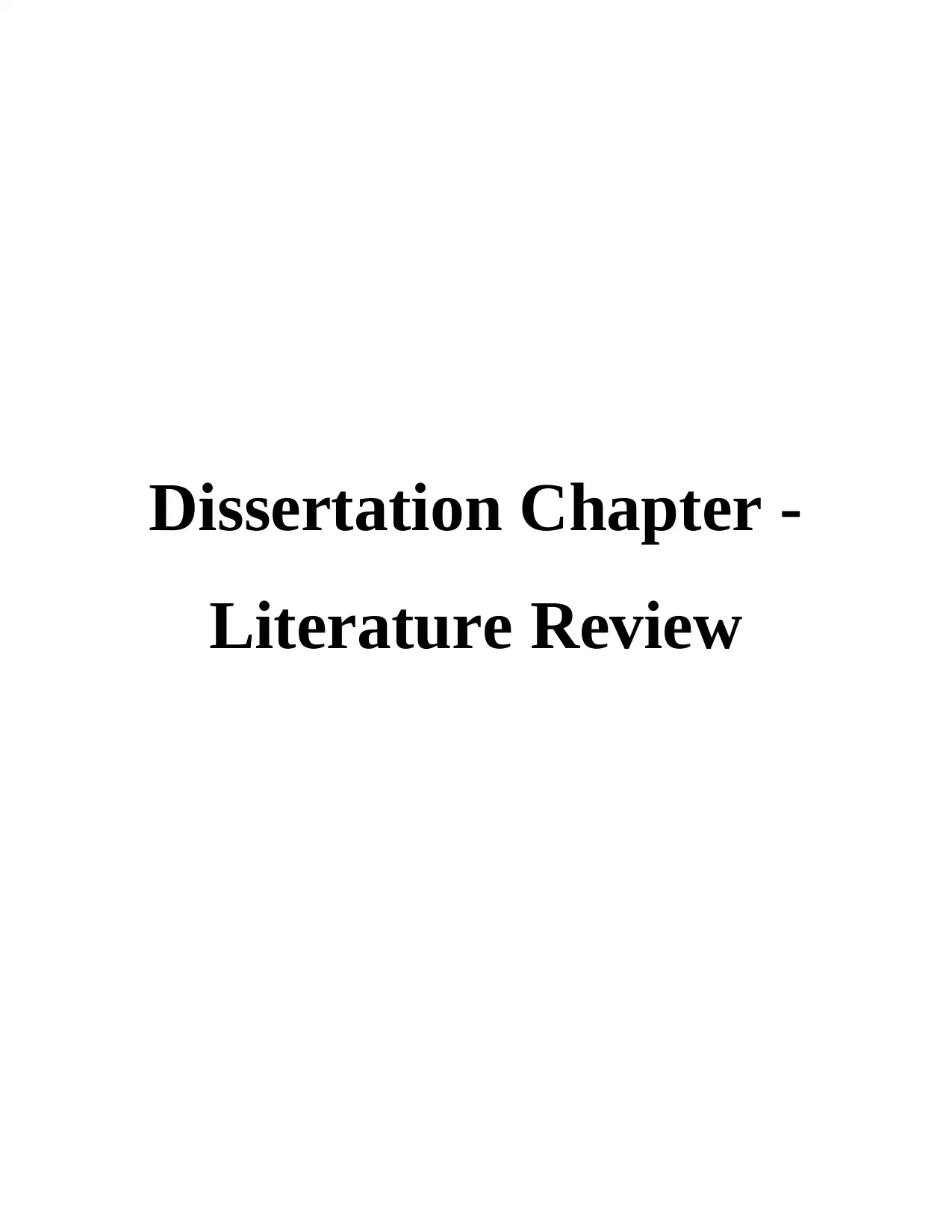
Dissertation Chapter -
Literature Review
Literature Review
Paraphrase This Document
Need a fresh take? Get an instant paraphrase of this document with our AI Paraphraser
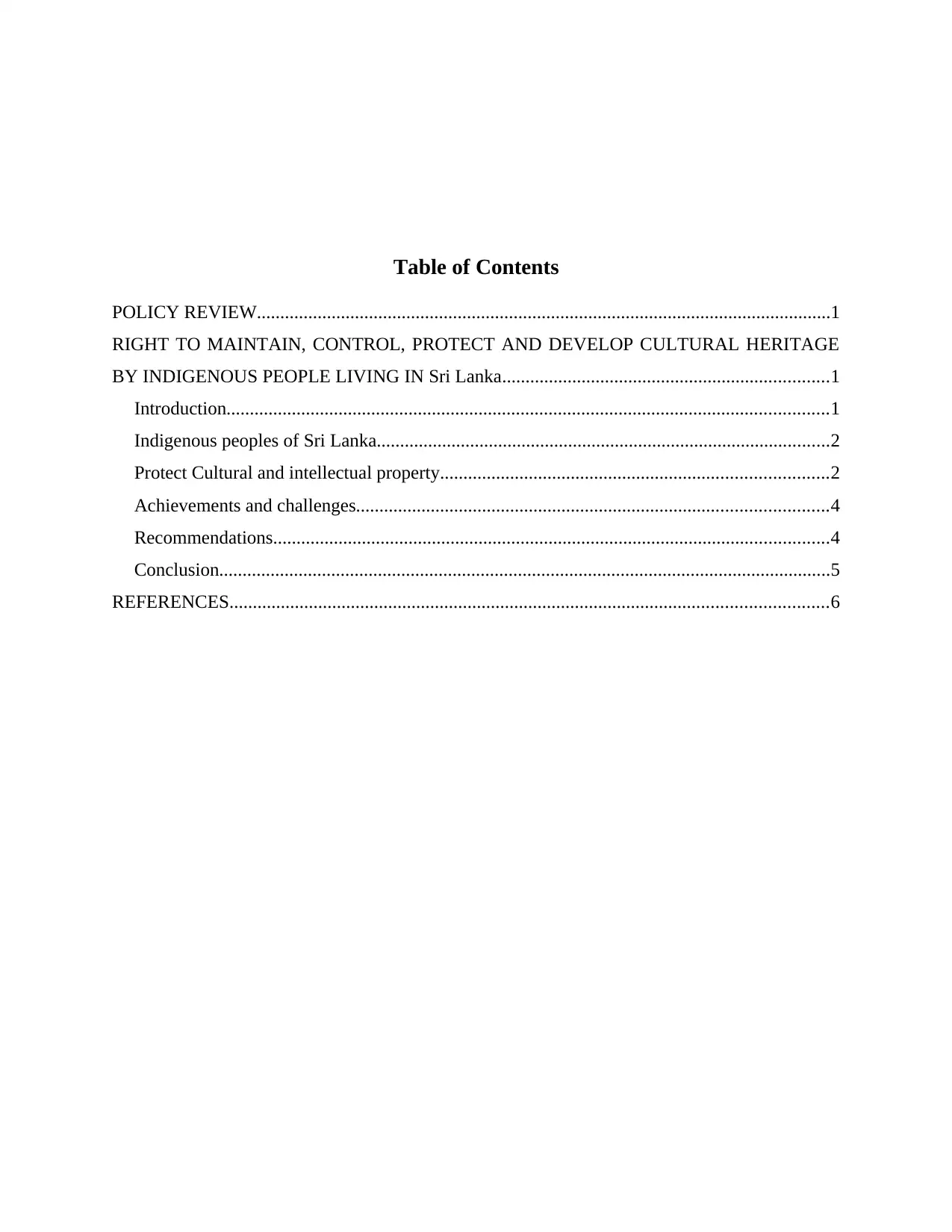
Table of Contents
POLICY REVIEW...........................................................................................................................1
RIGHT TO MAINTAIN, CONTROL, PROTECT AND DEVELOP CULTURAL HERITAGE
BY INDIGENOUS PEOPLE LIVING IN Sri Lanka......................................................................1
Introduction.................................................................................................................................1
Indigenous peoples of Sri Lanka.................................................................................................2
Protect Cultural and intellectual property...................................................................................2
Achievements and challenges.....................................................................................................4
Recommendations.......................................................................................................................4
Conclusion...................................................................................................................................5
REFERENCES................................................................................................................................6
POLICY REVIEW...........................................................................................................................1
RIGHT TO MAINTAIN, CONTROL, PROTECT AND DEVELOP CULTURAL HERITAGE
BY INDIGENOUS PEOPLE LIVING IN Sri Lanka......................................................................1
Introduction.................................................................................................................................1
Indigenous peoples of Sri Lanka.................................................................................................2
Protect Cultural and intellectual property...................................................................................2
Achievements and challenges.....................................................................................................4
Recommendations.......................................................................................................................4
Conclusion...................................................................................................................................5
REFERENCES................................................................................................................................6
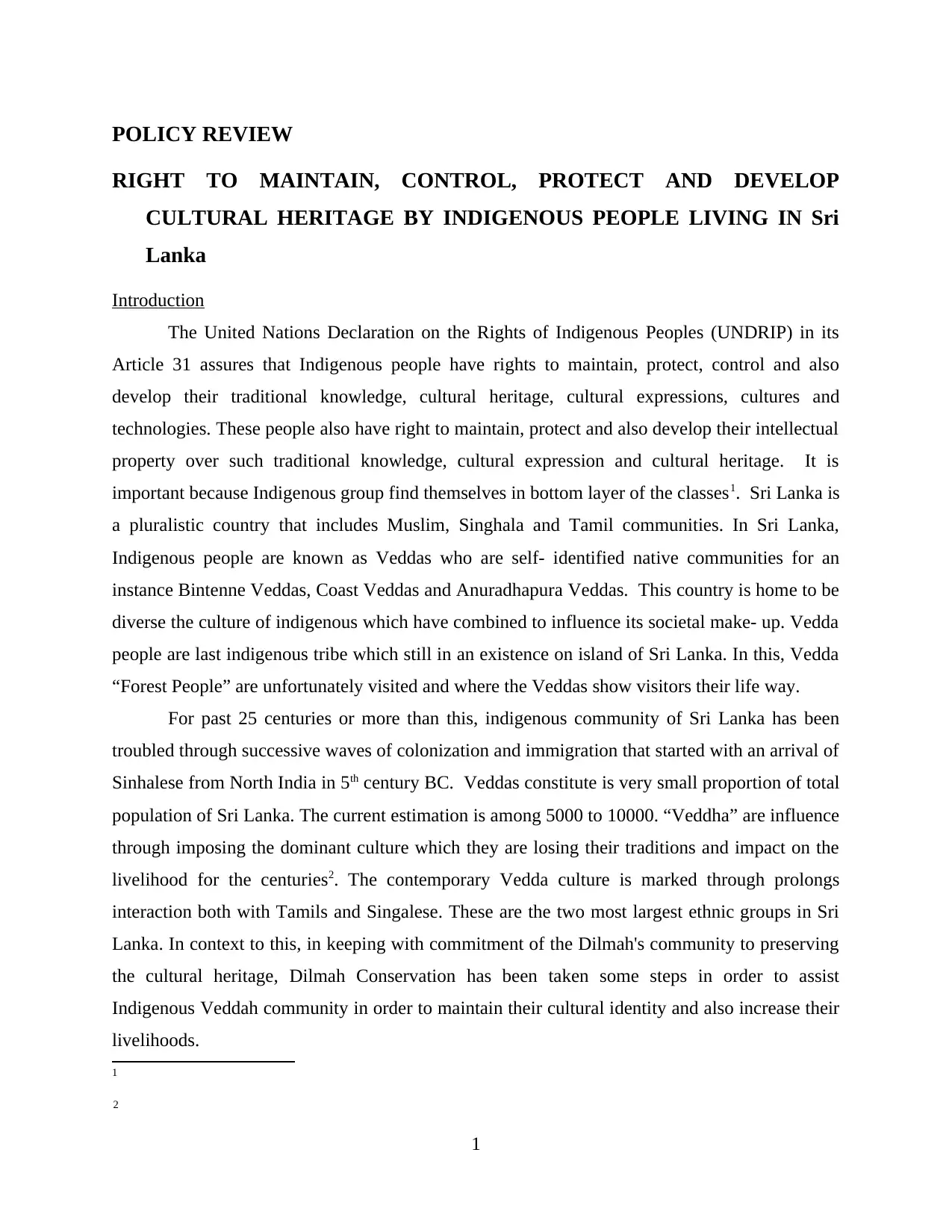
POLICY REVIEW
RIGHT TO MAINTAIN, CONTROL, PROTECT AND DEVELOP
CULTURAL HERITAGE BY INDIGENOUS PEOPLE LIVING IN Sri
Lanka
Introduction
The United Nations Declaration on the Rights of Indigenous Peoples (UNDRIP) in its
Article 31 assures that Indigenous people have rights to maintain, protect, control and also
develop their traditional knowledge, cultural heritage, cultural expressions, cultures and
technologies. These people also have right to maintain, protect and also develop their intellectual
property over such traditional knowledge, cultural expression and cultural heritage. It is
important because Indigenous group find themselves in bottom layer of the classes1. Sri Lanka is
a pluralistic country that includes Muslim, Singhala and Tamil communities. In Sri Lanka,
Indigenous people are known as Veddas who are self- identified native communities for an
instance Bintenne Veddas, Coast Veddas and Anuradhapura Veddas. This country is home to be
diverse the culture of indigenous which have combined to influence its societal make- up. Vedda
people are last indigenous tribe which still in an existence on island of Sri Lanka. In this, Vedda
“Forest People” are unfortunately visited and where the Veddas show visitors their life way.
For past 25 centuries or more than this, indigenous community of Sri Lanka has been
troubled through successive waves of colonization and immigration that started with an arrival of
Sinhalese from North India in 5th century BC. Veddas constitute is very small proportion of total
population of Sri Lanka. The current estimation is among 5000 to 10000. “Veddha” are influence
through imposing the dominant culture which they are losing their traditions and impact on the
livelihood for the centuries2. The contemporary Vedda culture is marked through prolongs
interaction both with Tamils and Singalese. These are the two most largest ethnic groups in Sri
Lanka. In context to this, in keeping with commitment of the Dilmah's community to preserving
the cultural heritage, Dilmah Conservation has been taken some steps in order to assist
Indigenous Veddah community in order to maintain their cultural identity and also increase their
livelihoods.
1
2
1
RIGHT TO MAINTAIN, CONTROL, PROTECT AND DEVELOP
CULTURAL HERITAGE BY INDIGENOUS PEOPLE LIVING IN Sri
Lanka
Introduction
The United Nations Declaration on the Rights of Indigenous Peoples (UNDRIP) in its
Article 31 assures that Indigenous people have rights to maintain, protect, control and also
develop their traditional knowledge, cultural heritage, cultural expressions, cultures and
technologies. These people also have right to maintain, protect and also develop their intellectual
property over such traditional knowledge, cultural expression and cultural heritage. It is
important because Indigenous group find themselves in bottom layer of the classes1. Sri Lanka is
a pluralistic country that includes Muslim, Singhala and Tamil communities. In Sri Lanka,
Indigenous people are known as Veddas who are self- identified native communities for an
instance Bintenne Veddas, Coast Veddas and Anuradhapura Veddas. This country is home to be
diverse the culture of indigenous which have combined to influence its societal make- up. Vedda
people are last indigenous tribe which still in an existence on island of Sri Lanka. In this, Vedda
“Forest People” are unfortunately visited and where the Veddas show visitors their life way.
For past 25 centuries or more than this, indigenous community of Sri Lanka has been
troubled through successive waves of colonization and immigration that started with an arrival of
Sinhalese from North India in 5th century BC. Veddas constitute is very small proportion of total
population of Sri Lanka. The current estimation is among 5000 to 10000. “Veddha” are influence
through imposing the dominant culture which they are losing their traditions and impact on the
livelihood for the centuries2. The contemporary Vedda culture is marked through prolongs
interaction both with Tamils and Singalese. These are the two most largest ethnic groups in Sri
Lanka. In context to this, in keeping with commitment of the Dilmah's community to preserving
the cultural heritage, Dilmah Conservation has been taken some steps in order to assist
Indigenous Veddah community in order to maintain their cultural identity and also increase their
livelihoods.
1
2
1
⊘ This is a preview!⊘
Do you want full access?
Subscribe today to unlock all pages.

Trusted by 1+ million students worldwide
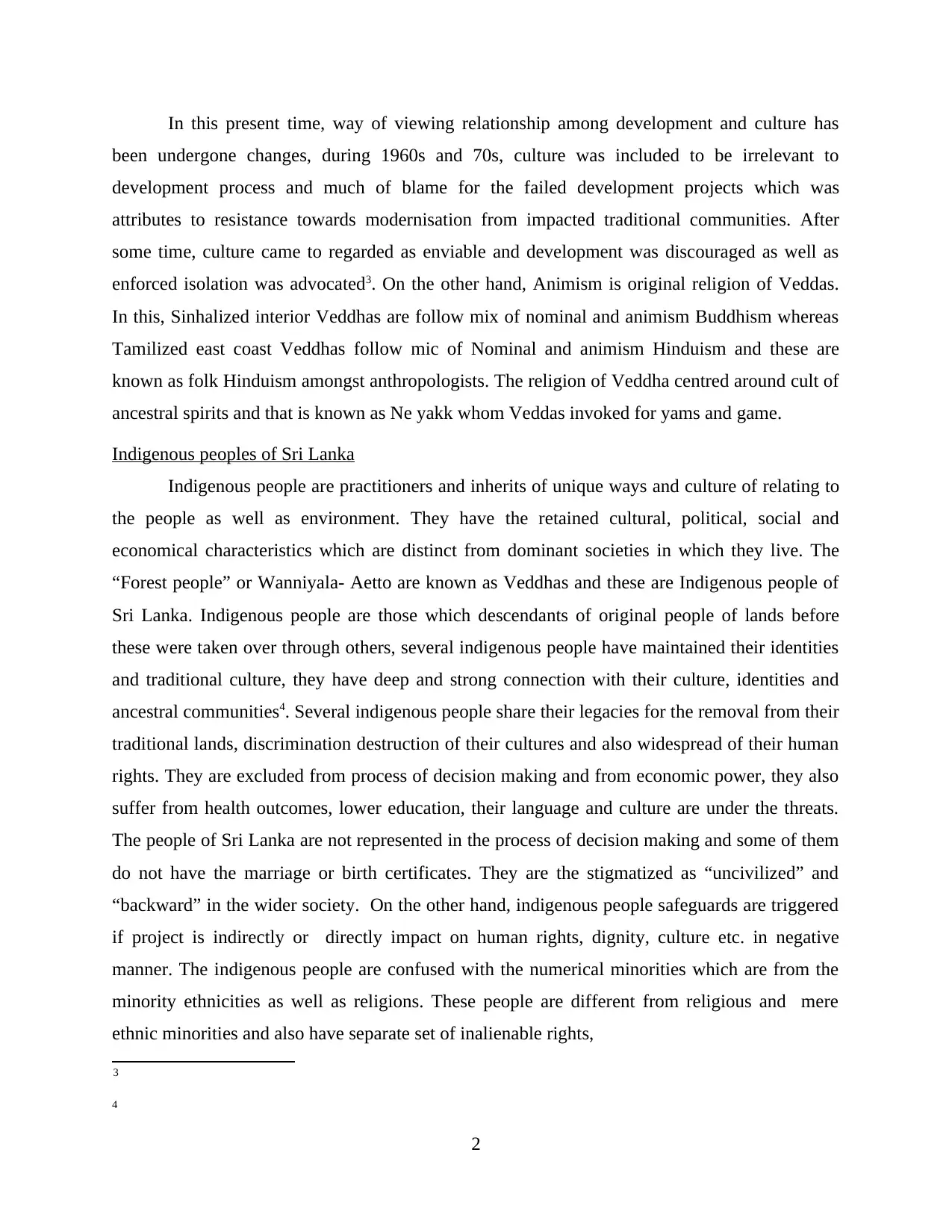
In this present time, way of viewing relationship among development and culture has
been undergone changes, during 1960s and 70s, culture was included to be irrelevant to
development process and much of blame for the failed development projects which was
attributes to resistance towards modernisation from impacted traditional communities. After
some time, culture came to regarded as enviable and development was discouraged as well as
enforced isolation was advocated3. On the other hand, Animism is original religion of Veddas.
In this, Sinhalized interior Veddhas are follow mix of nominal and animism Buddhism whereas
Tamilized east coast Veddhas follow mic of Nominal and animism Hinduism and these are
known as folk Hinduism amongst anthropologists. The religion of Veddha centred around cult of
ancestral spirits and that is known as Ne yakk whom Veddas invoked for yams and game.
Indigenous peoples of Sri Lanka
Indigenous people are practitioners and inherits of unique ways and culture of relating to
the people as well as environment. They have the retained cultural, political, social and
economical characteristics which are distinct from dominant societies in which they live. The
“Forest people” or Wanniyala- Aetto are known as Veddhas and these are Indigenous people of
Sri Lanka. Indigenous people are those which descendants of original people of lands before
these were taken over through others, several indigenous people have maintained their identities
and traditional culture, they have deep and strong connection with their culture, identities and
ancestral communities4. Several indigenous people share their legacies for the removal from their
traditional lands, discrimination destruction of their cultures and also widespread of their human
rights. They are excluded from process of decision making and from economic power, they also
suffer from health outcomes, lower education, their language and culture are under the threats.
The people of Sri Lanka are not represented in the process of decision making and some of them
do not have the marriage or birth certificates. They are the stigmatized as “uncivilized” and
“backward” in the wider society. On the other hand, indigenous people safeguards are triggered
if project is indirectly or directly impact on human rights, dignity, culture etc. in negative
manner. The indigenous people are confused with the numerical minorities which are from the
minority ethnicities as well as religions. These people are different from religious and mere
ethnic minorities and also have separate set of inalienable rights,
3
4
2
been undergone changes, during 1960s and 70s, culture was included to be irrelevant to
development process and much of blame for the failed development projects which was
attributes to resistance towards modernisation from impacted traditional communities. After
some time, culture came to regarded as enviable and development was discouraged as well as
enforced isolation was advocated3. On the other hand, Animism is original religion of Veddas.
In this, Sinhalized interior Veddhas are follow mix of nominal and animism Buddhism whereas
Tamilized east coast Veddhas follow mic of Nominal and animism Hinduism and these are
known as folk Hinduism amongst anthropologists. The religion of Veddha centred around cult of
ancestral spirits and that is known as Ne yakk whom Veddas invoked for yams and game.
Indigenous peoples of Sri Lanka
Indigenous people are practitioners and inherits of unique ways and culture of relating to
the people as well as environment. They have the retained cultural, political, social and
economical characteristics which are distinct from dominant societies in which they live. The
“Forest people” or Wanniyala- Aetto are known as Veddhas and these are Indigenous people of
Sri Lanka. Indigenous people are those which descendants of original people of lands before
these were taken over through others, several indigenous people have maintained their identities
and traditional culture, they have deep and strong connection with their culture, identities and
ancestral communities4. Several indigenous people share their legacies for the removal from their
traditional lands, discrimination destruction of their cultures and also widespread of their human
rights. They are excluded from process of decision making and from economic power, they also
suffer from health outcomes, lower education, their language and culture are under the threats.
The people of Sri Lanka are not represented in the process of decision making and some of them
do not have the marriage or birth certificates. They are the stigmatized as “uncivilized” and
“backward” in the wider society. On the other hand, indigenous people safeguards are triggered
if project is indirectly or directly impact on human rights, dignity, culture etc. in negative
manner. The indigenous people are confused with the numerical minorities which are from the
minority ethnicities as well as religions. These people are different from religious and mere
ethnic minorities and also have separate set of inalienable rights,
3
4
2
Paraphrase This Document
Need a fresh take? Get an instant paraphrase of this document with our AI Paraphraser
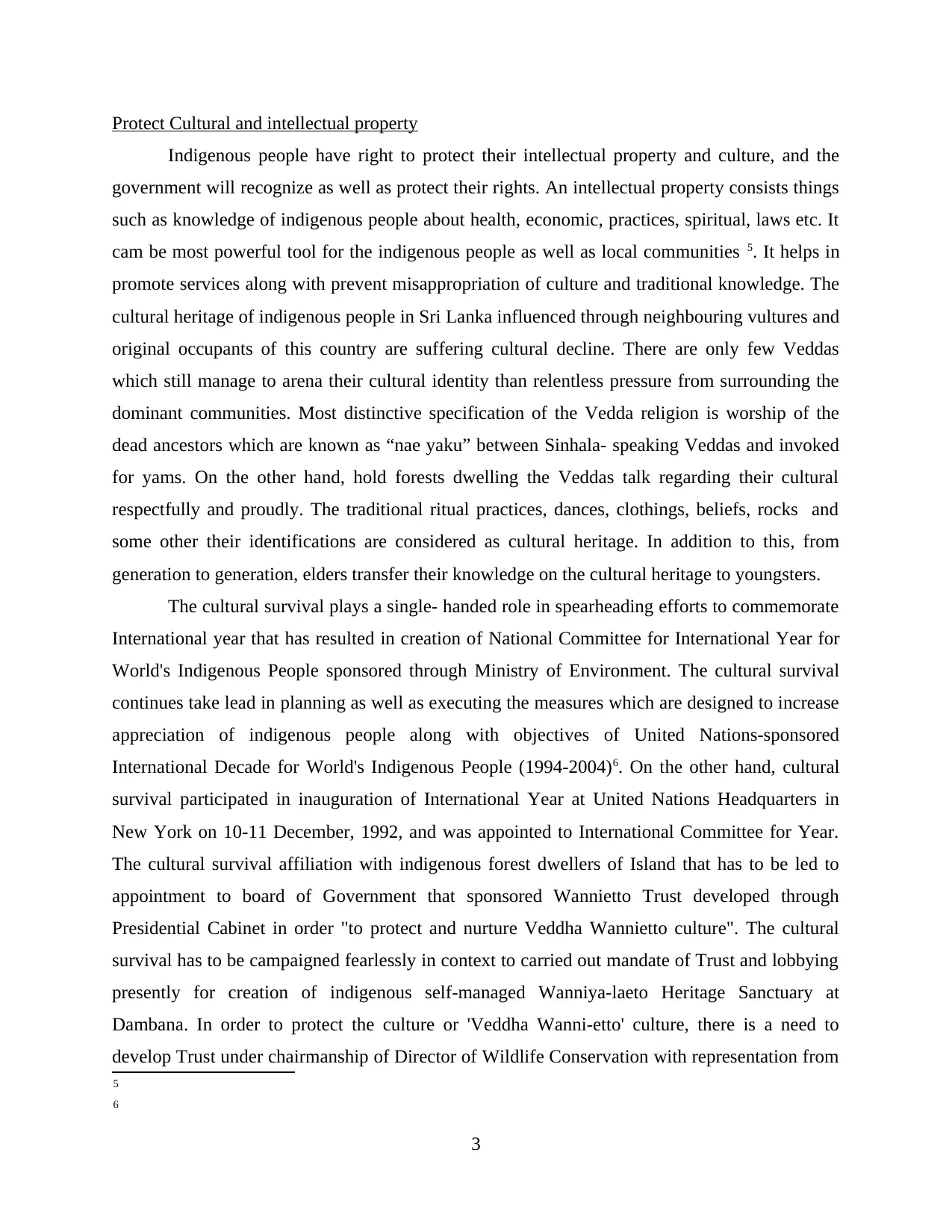
Protect Cultural and intellectual property
Indigenous people have right to protect their intellectual property and culture, and the
government will recognize as well as protect their rights. An intellectual property consists things
such as knowledge of indigenous people about health, economic, practices, spiritual, laws etc. It
cam be most powerful tool for the indigenous people as well as local communities 5. It helps in
promote services along with prevent misappropriation of culture and traditional knowledge. The
cultural heritage of indigenous people in Sri Lanka influenced through neighbouring vultures and
original occupants of this country are suffering cultural decline. There are only few Veddas
which still manage to arena their cultural identity than relentless pressure from surrounding the
dominant communities. Most distinctive specification of the Vedda religion is worship of the
dead ancestors which are known as “nae yaku” between Sinhala- speaking Veddas and invoked
for yams. On the other hand, hold forests dwelling the Veddas talk regarding their cultural
respectfully and proudly. The traditional ritual practices, dances, clothings, beliefs, rocks and
some other their identifications are considered as cultural heritage. In addition to this, from
generation to generation, elders transfer their knowledge on the cultural heritage to youngsters.
The cultural survival plays a single- handed role in spearheading efforts to commemorate
International year that has resulted in creation of National Committee for International Year for
World's Indigenous People sponsored through Ministry of Environment. The cultural survival
continues take lead in planning as well as executing the measures which are designed to increase
appreciation of indigenous people along with objectives of United Nations-sponsored
International Decade for World's Indigenous People (1994-2004)6. On the other hand, cultural
survival participated in inauguration of International Year at United Nations Headquarters in
New York on 10-11 December, 1992, and was appointed to International Committee for Year.
The cultural survival affiliation with indigenous forest dwellers of Island that has to be led to
appointment to board of Government that sponsored Wannietto Trust developed through
Presidential Cabinet in order "to protect and nurture Veddha Wannietto culture". The cultural
survival has to be campaigned fearlessly in context to carried out mandate of Trust and lobbying
presently for creation of indigenous self-managed Wanniya-laeto Heritage Sanctuary at
Dambana. In order to protect the culture or 'Veddha Wanni-etto' culture, there is a need to
develop Trust under chairmanship of Director of Wildlife Conservation with representation from
5
6
3
Indigenous people have right to protect their intellectual property and culture, and the
government will recognize as well as protect their rights. An intellectual property consists things
such as knowledge of indigenous people about health, economic, practices, spiritual, laws etc. It
cam be most powerful tool for the indigenous people as well as local communities 5. It helps in
promote services along with prevent misappropriation of culture and traditional knowledge. The
cultural heritage of indigenous people in Sri Lanka influenced through neighbouring vultures and
original occupants of this country are suffering cultural decline. There are only few Veddas
which still manage to arena their cultural identity than relentless pressure from surrounding the
dominant communities. Most distinctive specification of the Vedda religion is worship of the
dead ancestors which are known as “nae yaku” between Sinhala- speaking Veddas and invoked
for yams. On the other hand, hold forests dwelling the Veddas talk regarding their cultural
respectfully and proudly. The traditional ritual practices, dances, clothings, beliefs, rocks and
some other their identifications are considered as cultural heritage. In addition to this, from
generation to generation, elders transfer their knowledge on the cultural heritage to youngsters.
The cultural survival plays a single- handed role in spearheading efforts to commemorate
International year that has resulted in creation of National Committee for International Year for
World's Indigenous People sponsored through Ministry of Environment. The cultural survival
continues take lead in planning as well as executing the measures which are designed to increase
appreciation of indigenous people along with objectives of United Nations-sponsored
International Decade for World's Indigenous People (1994-2004)6. On the other hand, cultural
survival participated in inauguration of International Year at United Nations Headquarters in
New York on 10-11 December, 1992, and was appointed to International Committee for Year.
The cultural survival affiliation with indigenous forest dwellers of Island that has to be led to
appointment to board of Government that sponsored Wannietto Trust developed through
Presidential Cabinet in order "to protect and nurture Veddha Wannietto culture". The cultural
survival has to be campaigned fearlessly in context to carried out mandate of Trust and lobbying
presently for creation of indigenous self-managed Wanniya-laeto Heritage Sanctuary at
Dambana. In order to protect the culture or 'Veddha Wanni-etto' culture, there is a need to
develop Trust under chairmanship of Director of Wildlife Conservation with representation from
5
6
3
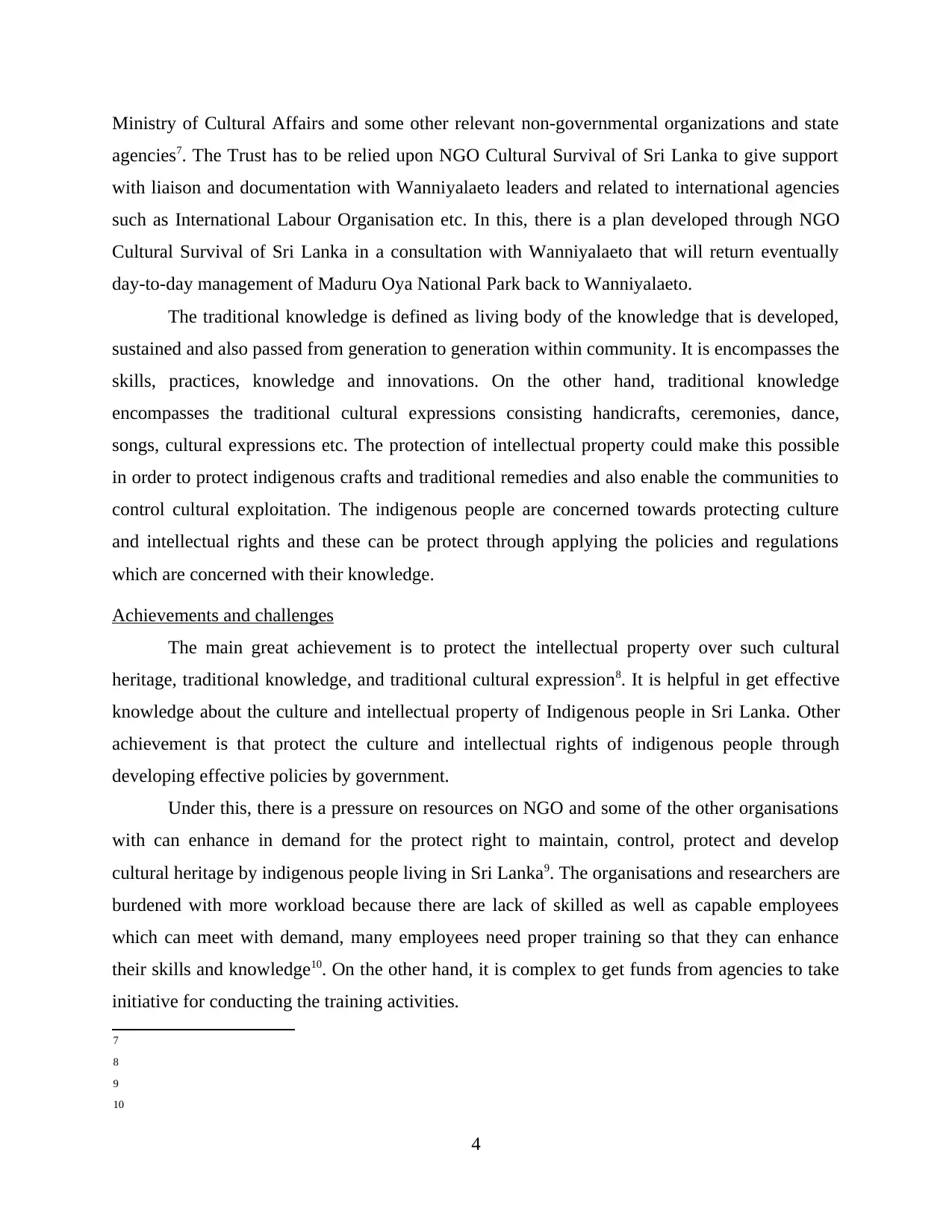
Ministry of Cultural Affairs and some other relevant non-governmental organizations and state
agencies7. The Trust has to be relied upon NGO Cultural Survival of Sri Lanka to give support
with liaison and documentation with Wanniyalaeto leaders and related to international agencies
such as International Labour Organisation etc. In this, there is a plan developed through NGO
Cultural Survival of Sri Lanka in a consultation with Wanniyalaeto that will return eventually
day-to-day management of Maduru Oya National Park back to Wanniyalaeto.
The traditional knowledge is defined as living body of the knowledge that is developed,
sustained and also passed from generation to generation within community. It is encompasses the
skills, practices, knowledge and innovations. On the other hand, traditional knowledge
encompasses the traditional cultural expressions consisting handicrafts, ceremonies, dance,
songs, cultural expressions etc. The protection of intellectual property could make this possible
in order to protect indigenous crafts and traditional remedies and also enable the communities to
control cultural exploitation. The indigenous people are concerned towards protecting culture
and intellectual rights and these can be protect through applying the policies and regulations
which are concerned with their knowledge.
Achievements and challenges
The main great achievement is to protect the intellectual property over such cultural
heritage, traditional knowledge, and traditional cultural expression8. It is helpful in get effective
knowledge about the culture and intellectual property of Indigenous people in Sri Lanka. Other
achievement is that protect the culture and intellectual rights of indigenous people through
developing effective policies by government.
Under this, there is a pressure on resources on NGO and some of the other organisations
with can enhance in demand for the protect right to maintain, control, protect and develop
cultural heritage by indigenous people living in Sri Lanka9. The organisations and researchers are
burdened with more workload because there are lack of skilled as well as capable employees
which can meet with demand, many employees need proper training so that they can enhance
their skills and knowledge10. On the other hand, it is complex to get funds from agencies to take
initiative for conducting the training activities.
7
8
9
10
4
agencies7. The Trust has to be relied upon NGO Cultural Survival of Sri Lanka to give support
with liaison and documentation with Wanniyalaeto leaders and related to international agencies
such as International Labour Organisation etc. In this, there is a plan developed through NGO
Cultural Survival of Sri Lanka in a consultation with Wanniyalaeto that will return eventually
day-to-day management of Maduru Oya National Park back to Wanniyalaeto.
The traditional knowledge is defined as living body of the knowledge that is developed,
sustained and also passed from generation to generation within community. It is encompasses the
skills, practices, knowledge and innovations. On the other hand, traditional knowledge
encompasses the traditional cultural expressions consisting handicrafts, ceremonies, dance,
songs, cultural expressions etc. The protection of intellectual property could make this possible
in order to protect indigenous crafts and traditional remedies and also enable the communities to
control cultural exploitation. The indigenous people are concerned towards protecting culture
and intellectual rights and these can be protect through applying the policies and regulations
which are concerned with their knowledge.
Achievements and challenges
The main great achievement is to protect the intellectual property over such cultural
heritage, traditional knowledge, and traditional cultural expression8. It is helpful in get effective
knowledge about the culture and intellectual property of Indigenous people in Sri Lanka. Other
achievement is that protect the culture and intellectual rights of indigenous people through
developing effective policies by government.
Under this, there is a pressure on resources on NGO and some of the other organisations
with can enhance in demand for the protect right to maintain, control, protect and develop
cultural heritage by indigenous people living in Sri Lanka9. The organisations and researchers are
burdened with more workload because there are lack of skilled as well as capable employees
which can meet with demand, many employees need proper training so that they can enhance
their skills and knowledge10. On the other hand, it is complex to get funds from agencies to take
initiative for conducting the training activities.
7
8
9
10
4
⊘ This is a preview!⊘
Do you want full access?
Subscribe today to unlock all pages.

Trusted by 1+ million students worldwide
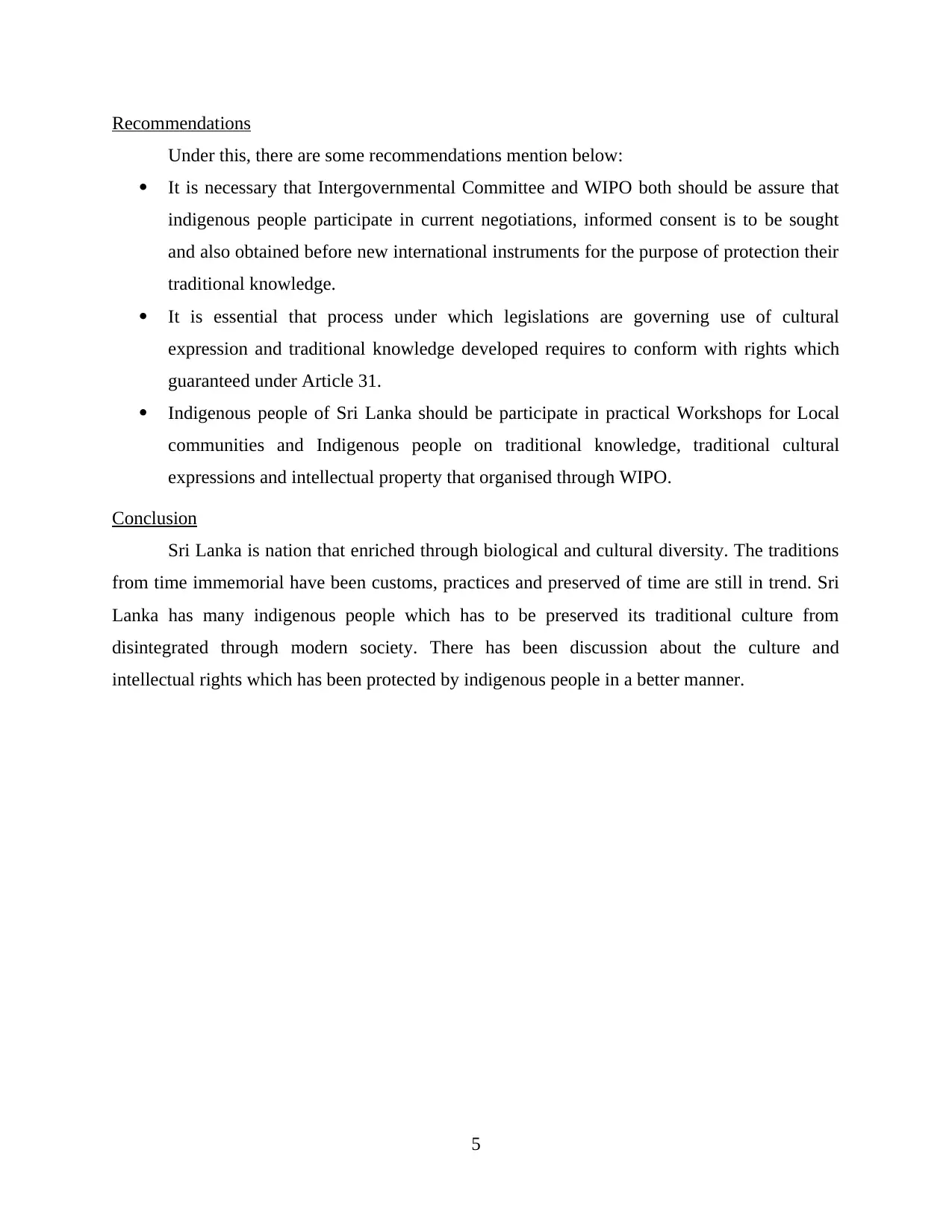
Recommendations
Under this, there are some recommendations mention below:
It is necessary that Intergovernmental Committee and WIPO both should be assure that
indigenous people participate in current negotiations, informed consent is to be sought
and also obtained before new international instruments for the purpose of protection their
traditional knowledge.
It is essential that process under which legislations are governing use of cultural
expression and traditional knowledge developed requires to conform with rights which
guaranteed under Article 31.
Indigenous people of Sri Lanka should be participate in practical Workshops for Local
communities and Indigenous people on traditional knowledge, traditional cultural
expressions and intellectual property that organised through WIPO.
Conclusion
Sri Lanka is nation that enriched through biological and cultural diversity. The traditions
from time immemorial have been customs, practices and preserved of time are still in trend. Sri
Lanka has many indigenous people which has to be preserved its traditional culture from
disintegrated through modern society. There has been discussion about the culture and
intellectual rights which has been protected by indigenous people in a better manner.
5
Under this, there are some recommendations mention below:
It is necessary that Intergovernmental Committee and WIPO both should be assure that
indigenous people participate in current negotiations, informed consent is to be sought
and also obtained before new international instruments for the purpose of protection their
traditional knowledge.
It is essential that process under which legislations are governing use of cultural
expression and traditional knowledge developed requires to conform with rights which
guaranteed under Article 31.
Indigenous people of Sri Lanka should be participate in practical Workshops for Local
communities and Indigenous people on traditional knowledge, traditional cultural
expressions and intellectual property that organised through WIPO.
Conclusion
Sri Lanka is nation that enriched through biological and cultural diversity. The traditions
from time immemorial have been customs, practices and preserved of time are still in trend. Sri
Lanka has many indigenous people which has to be preserved its traditional culture from
disintegrated through modern society. There has been discussion about the culture and
intellectual rights which has been protected by indigenous people in a better manner.
5
Paraphrase This Document
Need a fresh take? Get an instant paraphrase of this document with our AI Paraphraser
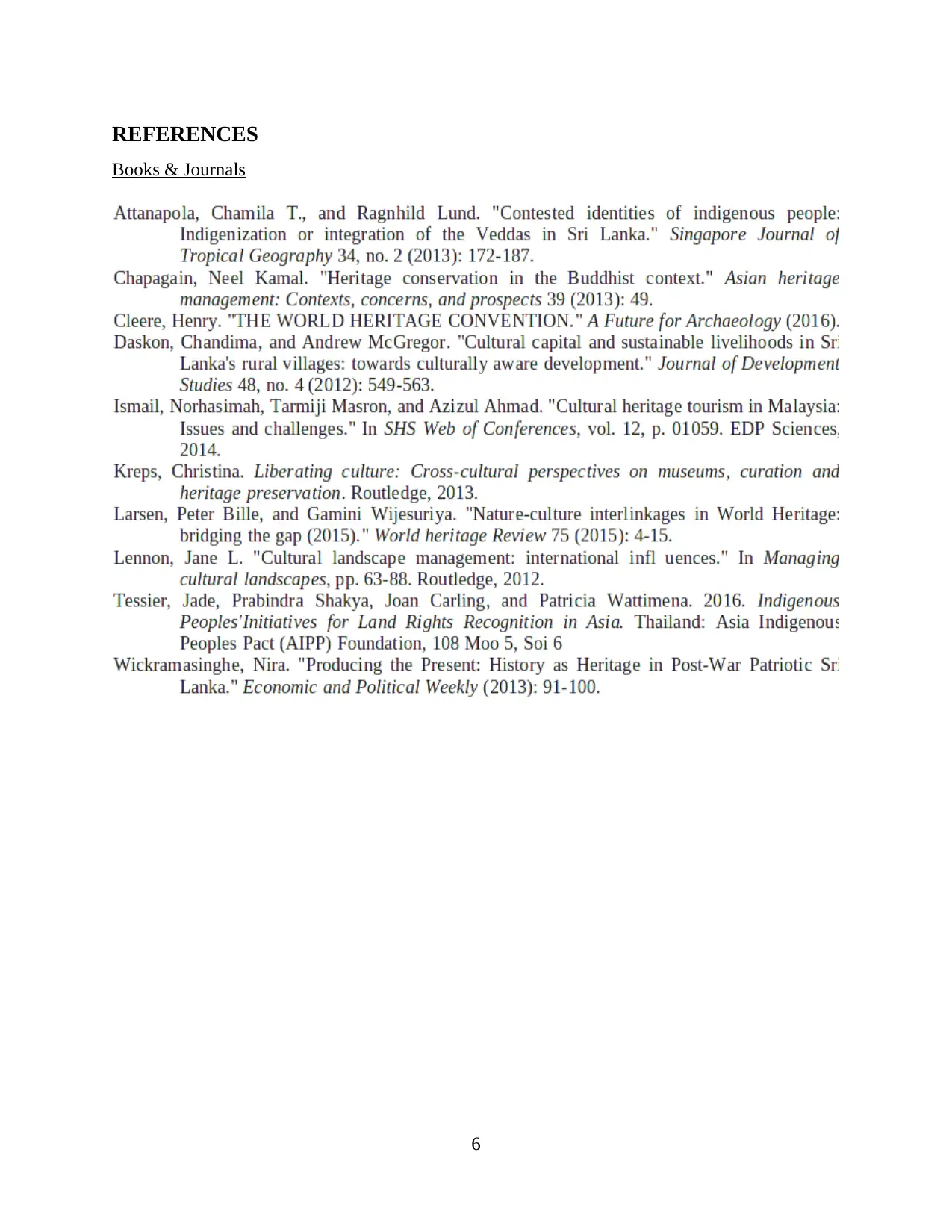
REFERENCES
Books & Journals
6
Books & Journals
6
1 out of 8
Your All-in-One AI-Powered Toolkit for Academic Success.
+13062052269
info@desklib.com
Available 24*7 on WhatsApp / Email
![[object Object]](/_next/static/media/star-bottom.7253800d.svg)
Unlock your academic potential
Copyright © 2020–2025 A2Z Services. All Rights Reserved. Developed and managed by ZUCOL.
